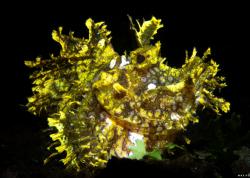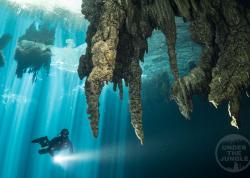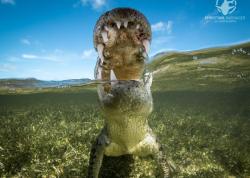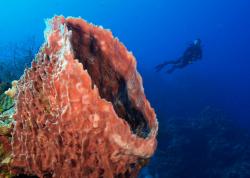Cozumel With A New Camera
Hello there, big boy! Is that a safety sausage in your BCD pocket or are you just glad to see me?" - actual quote from the Queen Angelfish pictured below
Queen angelfish (Holacanthus ciliaris)

The phone rings.
"Hello?"
"Hi, Jim, this is Scott from Bluewater Photo. When do you leave for Cozumel?"
"Hey, Scott! We leave Friday night."
"Well, you can pick up your new housing, strobes, lenses and ports on Wednesday."
"Really? Really? Excellent! See you tomorrow. Thanks Scott!"
After shooting an Olympus E-330 DSLR for six years, I was looking to upgrade my camera. My friend and camera guru, Roger, mentioned a few months ago that Olympus had just released a mirrorless camera I might want to look at. The new camera was getting rave reviews and might be the next-greatest-thing in underwater photography, but the camera had just come out, was backordered everywhere, and might take months to get. Because we were scheduled to leave for our annual three-week dive vacation in Cozumel within that timeframe, I figured there was no way I would have a camera, much less an underwater housing for it, by the time we left.
Downsizing from a DSLR
Like I said before, my friend Roger Carlson mentioned there a great new mirrorless camera, the Olympus OM-D. For myself , the advantage of the mirrorless camera is that there is no mirror to be flipped out of the way when you take a shot, so the response time when you press the shutter should be faster. I've never really been a mega-pixel chaser, but the 16 megapixels of the OM-D was very nice, and there was no noise at ISO 1600, which allows me to shoot in low light. But the nicest thing is the size - it is such a joy to take a small carry-on onto the plane. The entire rig with 2 strobes in just 10 pounds! It is also physically smaller than my dSLR setup. By the way, you can see some of Roger's great OM-D wide-angle shots of whale sharks in this Sea of Cortez article.
Fate Intervenes
Roger located a dealer who had a camera in stock and I was quick to order it with a 12-50mm kit lens. When Deborah and I took a week's vacation in Southern Utah in late June to look at rock formations (yes, I have other interests than SCUBA and bicycling), I packed my DSLR and put the EM5 in the camera bag for the heck of it. After taking a few pictures with the new camera, I pretty much left the E-330 in the bag and played with the EM5. Half the size and weight of a DSLR, the EM5 is easy to carry, is lightening-fast on auto-focus, and has a great dynamic range. I quickly fell in love with my new toy.
That left an underwater housing to get for the camera. Disappointingly, Ikelite announced they were NOT going to make a housing. Olympus was making a housing for the EM5, but it was going to be pricey and was not yet on the market in the USA. Rumors were circulating on scuba/camera bulletin boards that Nauticam was coming out with a housing for the EM5 but there was no way it would be available before we left for Mexico.
Fate continues to smile
A "top secret housing" had been made available for divers to try on a Nauticam dive trip; from descriptions of the housing, it was a prototype for the EM5. Then, in a surprise move, Nauticam announced they would begin shipping a few housings in early July. I immediately called Scott at BluewaterPhoto and asked when he could get me one. He said he would find out and let me know as soon as he did. Time passed…no word from Scott. Finally, he sent me an email and said he had placed his order with Nauticam, but the housings would be shipped only a few at a time to dealers. ETA? Early July? Oh, well.
Venus, Jupiter, and the Moon Approach Alignment
In the nick of time, only three days before our departure, Scott called and I drove up to Santa Monica to pick up my new housing, lens ports, a pair of Sea and Sea YS-D1 strobes, fiber optic cables, and other misc. bits and pieces! No time to get a dive in before we left, I would have to try out the new toys in Cozumel. BTW, Kelli at BlueWaterPhoto was both helpful and easy on the eyes.
[No lens port was available for my 12-50mm kit lens, so Scott offered to loan me a 14-42mm lens, port, and focus ring for the trip. Thank you, Scott, great customer service.]

My backpack and carryon luggage were ten-pounds lighter than usual. The new camera, housing, and strobes were that much lighter than the E-330 rig! Big smile!
We took the "red-eye" United flight to Houston and then on to Cozumel. All the bags arrived with us and we quickly boarded a van for the short drive to our home-away-from-home Scuba Club Cozumel. For those of you who have never met me, we have been visiting the island for over twenty years and always stay at SCC. You will find my rave reviews of Scuba Club in my previous trip reports here: Jim's Scuba Webpage
Scuba Club Cozumel

©Bonnie Pelnar, used with permission
Shore dive - My first time underwater with the new camera & housing.

I like this new camera and strobes. Autofocus is lightening-fast and dynamic range is superb. The lens port for the 8 mm fisheye lens is a tiny four-inch dome port. The whole rig weighs in at just over ten-pounds.
The Nauticam housing has great ergonomics; it fits perfectly in my hand and the controls are located in the right places. You cannot put the camera into the housing with the flash in the down or off position; a little wedge moves the flash into the on position when you insert the camera. Another added feature is access to the memory card and battery without having to remove the camera tray. Nice product.
Day 1 - Reef Star with Jesús
Deborah, me, Juanita, Mel, Mike, Betsy, Margaret, Walt, Scott, and Chris

Palancar Horseshoe; Paradise Reef
Grunt faces (Haemulon sp)

Caribbean spiny lobster (Panulirus argus)

Peacock flounder (Bothus lunatus)

Shore dive – macro with the 45 mm (equivalent to a 90 mm lens on film camera.)
Spotted cleaner shrimp (Pericimenes yucantanicus)

New eggs in Sgt Major "nest"
Sergeant major (Abudefduf saxatilus)

Sgt Major eggs with eyes
Sergeant major (Abudefduf saxatilus)

Spiral
Christmas tree worm (Spirobranchus giganteus)

The 45mm macro lens takes nice close ups, but hunts for focus in low light…a lot! Roger suggested using a single autofocus spot, but the lens was still slow to focus. A 60mm macro lens is in the works for this camera.
Day 2 - Reef Diver with Jesús – 14–45 mm zoom.
I must say, this is a very nice versatile lens for fish portraits with uber-fast autofocus.
La Francesa

Juvenile spotted drum (Equetus punctatus) Yes, Virginia, the juvenile spotted drum doesn't have any spots…just stripes. Go figure.

Yucab
Black grouper (Mycteroperca bonaci) This big guy has been hanging out at Yucab Reef for several years. He's used to divers and isn't all that shy. Note the color variation from the usual black.


Shore dive –
Lantern bass (Serranus baldwini)

Nimble spray crab (Percnon gibbesi) These crabs are very shy. Ron Thackett posted some images that he had taken in front of SCC and inspired me to try to take some.

Banded clinging crab (Mitrax cinctimanus)

Grunts on the gate (Haelmun sp)

(Haemulon sp) "Weren't you here last August?"

Rough fileclam (Lima scabra)

Deborah and scorpionfish

Spotted scorpionfish (Scorpaena plumieri)

Yawn. I wasn't expecting a scorpionfish yawn, even less so with a camera in my hand. The lack of shutter lag on the new camera made it possible for me to get off a shot before the fish closed its mouth.

Day 3 – Reef Diver with Jesús – 14-45 mm zoom

Palancar Gardens
Margaret

Splendid toadfish (Sanopus splendidus) Endemic to Cozumel, splendid toadfish are difficult to photograph in their dens; light from the strobes has to be in exactly the right place. A smaller camera/housing makes it easier to get the strobes next to the lens so they shine into the hole.

Green moray (Gymnothorax funebris) One of the big animals on the reef.

Hawksbill turtle (Eretmochelys imbriocota) It's always a joy to see turtles. The Hawksbill is the most common turtle species in Cozumel and the population is healthy.

Painted elysia (Thuridilla picta) This is a tiny seaslug that is often found on little patches of green "grass," its food source.

Chankanaab
Lineshout goby (Gobiosoma sp)

Mike, Juanita, Mel, and Jesús

Shore dive
Evil looking octopus. This critter was in a hole and shadows from the strobes give the image an eerie tone.

Day 4 – Reef Diver with Jesús – 14-45 mm zoom
La Francesa
Margaret and sponge

Coney (Cephalopholis fulvus) Coneys look dull on the reef, but turn a beautiful red color under strobe light. They can be distinguished from Red Hinds by the two spots on their lower lip.

Loggerhead turtle (Caretta caretta) WOW, WOW, WOW! I've only seen a loggerhead once before. This was a big turtle, about three feet across, just slowly swimming into the current.

Gray angelfish (Pomacanthus arcuatus)

Tormentos
Queen conch (Strombus gigas) I just love the weird eyes of these mollusks.

Nurse shark (Ginglymostoma cirratum) Nurse sharks are common on Cozumel's reefs. Other shark species are not often seen.

Jesús in the window.


Shore – 45 mm macro + subsee 10x
The SubSee 10X adapter gives greater magnification to the 45 mm macro.
Lionfish ( Pterois volitans) Yes, the invasion by lionfish continues. I've heard it tastes like chicken.

Squat anemone shrimp (Thor amboinensis)

Spotted cleaner shrimp (Pericimenes yucantanicus) There were lots of these shrimp on anemones this year.

Yellowline arrow crab (Stenorhynchus seticornis)

Cardinal fish in anemone

Day 5 – Reef Diver with Jesús – 8 mm fisheye
I love, love, love this wide angle lens. One of my pet peeves has been the inability to capture images that show what it's really like to dive the huge coral structures on the deeper reefs. The 8 mm fisheye lets me get close to the reef and light up the sponges with divers on the wall. The 4-inch dome port is compact and easy to pack!
Reef Diver WA




Safety stop. I never did find out what they were doing.


Jesús' reef – Colombia Sur – wide angle heaven.
Jesús took us to a reef that he found by accident. Similar to Colombia, this reef sits deeper on the sand and gets shallower as you move from pinnacle to pinnacle. The day was perfect for wide angle photography: calm, gentle current, sunshine, and clear water.


Lionfish ( Pterois volitans)

San Francisco
Nurse shark (Ginglymostoma cirratum) and Sharksucker (Echeneis naucrates)

Shore – macro
A band of fish = trumpetfish, cornetfish, drum, guitarfish…etc.?
Trumpetfish (Aulostomus maculatus)

Day 6 – Reef Diver with Jesús – 14-42 mm
Santa Rosa Wall; El Paso de Cedral
Porkfish (Anisotremus virginicus) If you ever see a picture of a school of porkfish, it's likely the image was captured on el Paso de Cedral.


Shore – macro
White speckled hermit (Paguristes punticeps)

Painted elysia (Thuridilla picta)

Sex! Thuridilla reproduce via two mechanisms, hyperdermic transfer and reciprocal copulation. The first method involves injection of sperm into the body cavity of the partner, the second is a head to head mutual exchange of sperm. These two sacoglossans approached one another and neatly coiled into the position shown in the image. Coitus lasted about five minutes before the two slugs separated and went off on their own.

Junk yard dog
Purplemouth moray (Gymnothorax micinus)

Gumby
Purplemouth moray (Gymnothorax micinus)

Word came in that Tropical Storm Ernesto was forecast to turn into a category 1 hurricane and hit Cozumel on Wednesday.

Day 7 – Reef Diver with Manuel – 14-42 mm
Palancar Caves

Hawksbill turtle (Eretmochelys imbriocota)

Shore
Unknown fish in anemone

Yellowline arrow crab (Stenorhynchus seticornis)

Fringed filefish (Monacanthus ciliatus)

Day 8 – Reef Diver with Jesús – 14-42 mm + 10X SubSee

A few friends and relatives decided to come down and join us for the second week of our vacation!

I had my 10X SubSee adapter in my BCD pocket on this dive and decided to give it a try with the 14-42 lens. The lens port has 67 mm female-thread for wet-adapters. Wow! You can take macro pictures using the SubSee and this lens…and it's fast! At this point, I can see no reason to use the 45mm macro lens. In fact, the 14-42 is now my go-to lens for both fish portraits and macro…at least until I get a lens port for the 12-50.
El Paso del Cedral Wall
Hawksbill turtle (Eretmochelys imbriocota) El Gordo needs to go on a diet.

Coney (Cephalopholis fulvus)

Smooth trunkfish (Lactophrys triqueter)

Porkfish (Anisotremus virginicus)

Black grouper (Mycteroperca bonaci)

Paradise
Foureye butterflyfish (Chaetodon capistratus)

Shore
Slate pencil urchin (Eucidaris tribuloides)

Nimble spray crab (Percnon gibbesi)

Juvenile French angelfish (Pomacanthus paru)

Balloonfish (Diodon holocanthus)

Rough fileclam (Lima scabra)

Mushroom scorpionfish (Scorpeana inermis) These little scorpionfish are well camouflaged and I only saw them because they moved. At the top of the eye, you will see little, fleshy tabs that look like upside down mushrooms, hence the name.

Day 9 – Reef Cat with Jesús – 8 mm fisheye

Colombia Bricks; Yucab
You may notice, there are no pictures for Day 9. I broke rule number one, always take a picture after you have assembled the underwater rig to make sure everything is working correctly. I dropped in the water on the first dive and couldn't turn the camera on. The on/off switch had misaligned when I closed the door on the housing. Wouldn't you know it, a southern stingray let me get up close and personal but no picture?
I don't like to open a housing on a boat, so I dove cameraless on the second dive – very strange feeling not knowing what to do with my hands.
We didn't get back to the dock until 2:30, so lunch was later than usual. I opted to skip an afternoon shore dive. It looked like rain anyway.
The good news, Hurricane Ernesto had been forecast to slide a couple of hundred kilometers south of the island. We would get some rain, but no threat from the storm.
Coffee

Day 10 – Reef Cat with Jesús
Dalila
Red hind (Epinephelus guttatus)

Rock beauty (Holacanthus tricolor)

Villa Blanca
TWO seahorses
Longsnout seahorse (Hippocampus reidi)

Red sponge and arrowcrab
Yellowline arrow crab (Stenorhynchus seticornis)

Shore
James and Katje

Bumblebee shrimp (Gnathophyllum americanum) Think very, very small…about a quarter inch long and very quick. These shrimp are often found on seacumbers.

Day 11
Port closed due to tropical storm Ernesto. As expected, some rain but no strong winds.


No joy. The port stayed closed.
Shore dive
Sand divers (Synodus intermedius)

Jodi and Doug (newly engaged!)

Flying Gurnard (Dactylopterus volitans)

Spotted eel dentition – toothy little devil. What goes in that mouth doesn't come out.
Spotted moray (Gymnothorax moringa)
 eel
eel
Surge and poor visibility
Day 12 – Reef Cat with Jesús
Santa Rosa
Diamond pipefish (unidentified)

Hawksbill turtle (Eretmochelys imbriocota) "You've been coming here since I was this high!"

Captain of the Reef Cat

Tormentos - El Paso del Cedral (twilight)
Scrawled filefish (Aluterus scriptus)

Paradise (night)
Red night shrimp (Cinethorhynehus manningi) This was a new find for me. Mary Wicksten from Texas A&M University says they are common on the Flower Gardens.

Day 13 – Reef Cat with Jesús
San Francisco
Coney –bicolor phase - (Cephalopholis fulvus)

Spinyhead blenny (Acanthemblemaria spinosa) Having a great background is what makes this picture so much more interesting.

Chankanaab
Great barracuda (Sphyraena barracuda)

Green moray (Gymnothorax funebris) and Midnight parrotfish (Scarus coelestinus) The green moray was free swimming and I was following the midnight parrotfish. I didn't see the moray until he saw me and then ducked under a ledge

The big group's last day of diving.
Day 14 – Observer with Manuel
Colombia Deep
Boat briefing with Manuel


San Clemente
Green turtle (Chelonia mydas) Factoid: the green turtle is not named for the color of its shell, but the color of its fat! Green turtles are not common due to overharvesting. The Catholic Church views turtles as "fish" and, as such, can be consumed during Lent. As a result, thousands of turtles are poached for food each year. Please, write the Pope and suggest he clarify the list of "seafood."

Spanish hogfish (Bodianus rufus) cleaning a French angelfish

Shore
Red snapping shrimp (Alpheus spp.)

Sharptail eel (Myrichthys breviceps) NOT A SNAKE!

Sharptail eel (Myrichthys breviceps)

Day 15
I took the day off from boat diving…tummy rumbles.
Feeling better, I attempted a shore dive but didn't stay in the water long.
Day 16
Our dear friend Betsy was having ear problems and went into town to see a doctor. She had a perforated eardrum and could no longer dive until it healed. We were really bummed.
I took the day off, too.
Day 17 – Reef Cat with Jesús
Palancar Horseshoe
Villa Blanca
Spotted cleaner shrimp (Pericimenes yucantanicus) on a Sun anemone (Stichodactyla helianthus)

Opal was a popular Cozumel dive master who recently died in a tragic dive accident. This mermaid is a memorial to her. Unfortunately, the sand is eroding underneath and the block is listing badly.

Day 18 – Reef Cat with Jesús
Chris' nitrox reminder

Bolones de Chankanaab
Porkfish (Anisotremus virginicus)

Atlantis submarine

Chankanaab
Coney (Cephalopholis fulvus) I don't have a clue what this coney was doing. After I took this picture, he spit out a bunch of sand and continued standing on his fins.

Squirrelfish (Holocentrus adscensionis) Every trip report has to have a squirrelfish picture. Roger says I post the same picture every year, but it's not true.

Variable boring sponge (Siphonodictyon coralliphagum) How can a sponge be boring? Is there an entertaining sponge?

Spendid toadfish (Sanopus splendidus)

Googleeyes (unknown mantis shrimp)

Day 19 – Reef Cat with Jesús
This was Amy's fiftieth birthday! Happy Birthday, young lady! Not only was this Amy's birthday, but she completed her 500 th dive on Paradise! WTG, Amy.

Santa Rosa Wall
Deborah in window

More hawksbill turtles


Paradise
CFWA

George and seahorse

Day 20 – Reef Cat with Jesús
Dalila
Turtle with entourage
Hawksbill turtle (Eretmochelys imbriocota)

Caribbean spiny lobster (Panulirus argus)

El Paso del Cedral
Juvenile queen angelfish (Holacanthus ciliaris) Isn't a juvenile queen a princess?

Nurse shark (Ginglymostoma cirratum)

Odd couple?

Longsnout seahorse (Hippocampus reidi)

The end of our undersea adventure.

If you would like to know more about the new Olympus OM-D EM-5, here's a link to D P Review's in depth look at the camera:
http://www.dpreview.com/reviews/olympusem5
Another great getaway to Cozumel for wonderful warm-water diving. We will be back. In fact, I'm seriously considering spending the entire month of August at SCC next year.
My thoughts on the Nauticam OM-D E-M5 housing
The Nauticam housing is fantastic - the ergonomics of the housing is actually better than the camera itself, because the camera is a little small. All the controls are easily reachable, and you don't have to hold down an extra button to adjust the shutter speed or aperture. The OM-D has a nice super menu that allows you to adjust almost anything with only one or two clicks.
Further Reading
RECOMMENDED ARTICLES
SUPPORT THE UNDERWATER PHOTOGRAPHY GUIDE:
The Best Service & Prices on u/w Photo Gear
 Visit Bluewater Photo & Video for all your underwater photography and video gear. Click, or call the team at (310) 633-5052 for expert advice!
Visit Bluewater Photo & Video for all your underwater photography and video gear. Click, or call the team at (310) 633-5052 for expert advice!
The Best Pricing, Service & Expert Advice to Book your Dive Trips
 Bluewater Travel is your full-service scuba travel agency. Let our expert advisers plan and book your next dive vacation. Run by divers, for divers.
Bluewater Travel is your full-service scuba travel agency. Let our expert advisers plan and book your next dive vacation. Run by divers, for divers.
































